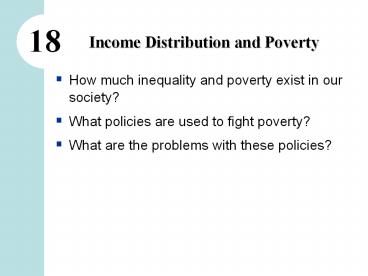Income Distribution and Poverty - PowerPoint PPT Presentation
Title:
Income Distribution and Poverty
Description:
What policies are used to fight poverty? What are the problems with these policies? ... below which a family is deemed to be in poverty ... – PowerPoint PPT presentation
Number of Views:471
Avg rating:3.0/5.0
Title: Income Distribution and Poverty
1
0
Income Distribution and Poverty
18
- How much inequality and poverty exist in our
society? - What policies are used to fight poverty?
- What are the problems with these policies?
2
Introduction
0
- Income is generally determined by earnings
- Earnings are a function of productivity
- What if productivity of resources varies across
individuals? - The result is income inequality.
3
The U.S. Income Distribution 2005
0
Group Annual household income
Bottom fifth Under 19,178
Second fifth 19,179 36,000
Middle fifth 36,001 57,658
Fourth fifth 57,659 91,705
Top fifth 91,706 and over
Top 5 percent 184,500 and over
4
The U.S. Income Distribution 2005
0
Group Share of total household income
Bottom fifth 3.4
Second fifth 8.6
Middle fifth 14.6
Fourth fifth 23.0
Top fifth 50.4
Top 5 percent 22.2
5
U.S. Inequality Over Time
0
Income share of the top 20 divided by income
share of the bottom 20
6
Lorenz Curve
- The distribution of income can be represented by
a Lorenz curve. - In a Lorenz curve
- the horizontal axis measures the cumulative
percentage of households - the vertical axis measures the cumulative
percentage of households
7
A C T I V E L E A R N I N G 1 Lorenz Curve
- Using the distribution of income for 2005, draw a
Lorenz curve.
Group Income Share
Bottom 20 3.4
2nd 20 8.6
Middle 20 14.6
4th 20 23.0
Top 20 50.4
6
8
A C T I V E L E A R N I N G 1 Answer
- Create cumulative totals of the columns.
Group Total Income Share Total Share
Bottom 20 20 3.4 3.4
2nd 20 40 8.6 12.0
Middle 20 60 14.6 26.6
4th 20 80 23.0 49.6
Top 20 100 50.4 100
7
9
A C T I V E L E A R N I N G 1 Answer
- Plot the cumulative number of households against
the total share.
8
10
A C T I V E L E A R N I N G 1 Answer
- A Lorenz curve that is a straight diagonal line
would indicate an equal distribution of income.
9
11
Gini Coefficient
- Another way to describe income inequality is by
using a Gini coefficient. - related to the Lorenz curve
12
Gini Coefficient
- Let A area between the line of perfect equality
and the Lorenz curve - Let B area below the Lorenz curve
Gini coefficient A /(A B)
A higher Gini coefficient means greater inequality
13
Gini Coefficient for the U.S.
14
Inequality Around the World
0
Income share of the top 20 divided by income
share of the bottom 20
15
Gini Coefficients Around the World
Country Gini Coefficient
South Africa 77.0
Brazil 60.7
Mexico 53.1
Nigeria 50.6
China 52.2
Russia 48.7
United States 46.9
United Kingdom 34.0
Canada 33.1
India 38.0
Germany 30.0
Japan 24.9
16
Gini Coefficients Around the World
Green greater equality Red greater
inequality
17
Poverty
0
- Poverty line an absolute level of income set
by the government for each family size below
which a family is deemed to be in poverty - Poverty rate the percentage of the population
whose family income falls below the poverty line - In 2005 in the U.S.,
- median household income 46,326
- poverty line for family of four 19,806
- poverty rate 12.6
18
The U.S. Poverty Rate Over Time
0
Percent of the population below poverty line
19
U.S. Poverty Rates by Group, 2005
0
Group Poverty Rate
All persons 12.6
White, not Hispanic 8.3
Black 24.9
Hispanic 21.8
Asian, Pacific Islander 11.1
Children 17.6
Elderly 10.1
Married-couple families 5.1
Female household, no spouse present 28.7
20
Policies to Reduce Poverty
0
- Poor families more likely to experience
- homelessness
- drug dependence
- health problems
- teen pregnancy
- illiteracy
- unemployment
- Most people believe the government should provide
a safety net. - We now consider a few such policies
21
1. Minimum-Wage Laws
0
- Arguments for
- helps the poor without any cost to the government
- little impact on employment if demand for
unskilled labor is relatively inelastic - Arguments against
- In the long run, demand for unskilled labor is
likely elastic, so minimum wage causes
substantial unemployment among the unskilled. - Those helped by minimum wage are more likely to
be teens from middle-income families than
low-income adult workers.
22
2. Welfare
0
- Welfare government programs that supplement the
incomes of the needy - Temporary Assistance for Needy Families (TANF)
- Supplemental Security Income (SSI)
- Critics argue that such programs create
incentives to become or remain needy - argue that welfare contributed to the rise of the
single-parent family - The severity of such incentive problems is unknown
23
3. Negative Income Tax
0
- Negative income tax a tax system that collects
revenue from high-income households and gives
transfers to low-income households - Example Taxes owed (1/3 of income) 10,000
- If earnings 90,000, taxes owed 20,000
- If earnings 60,000, taxes owed 10,000
- If earnings 30,000, taxes owed 0
- If earnings 15,000, taxes owed
5,000i.e., would receive 5000 payment from
govt - The Earned Income Tax Credit (EITC) is similar to
a negative income tax.
24
4. In-Kind Transfers
0
- In-kind transfers are goods or services provided
to the needy. Examples - homeless shelters
- soup kitchens
- food stamps
- Medicaid
- An alternative cash payments
25
Anti-Poverty Programs andWork Incentives
0
- Assistance from anti-poverty programs declines
as income rises. - Poor families face high effective marginal tax
rates (exceeding even 100 in some cases!)

